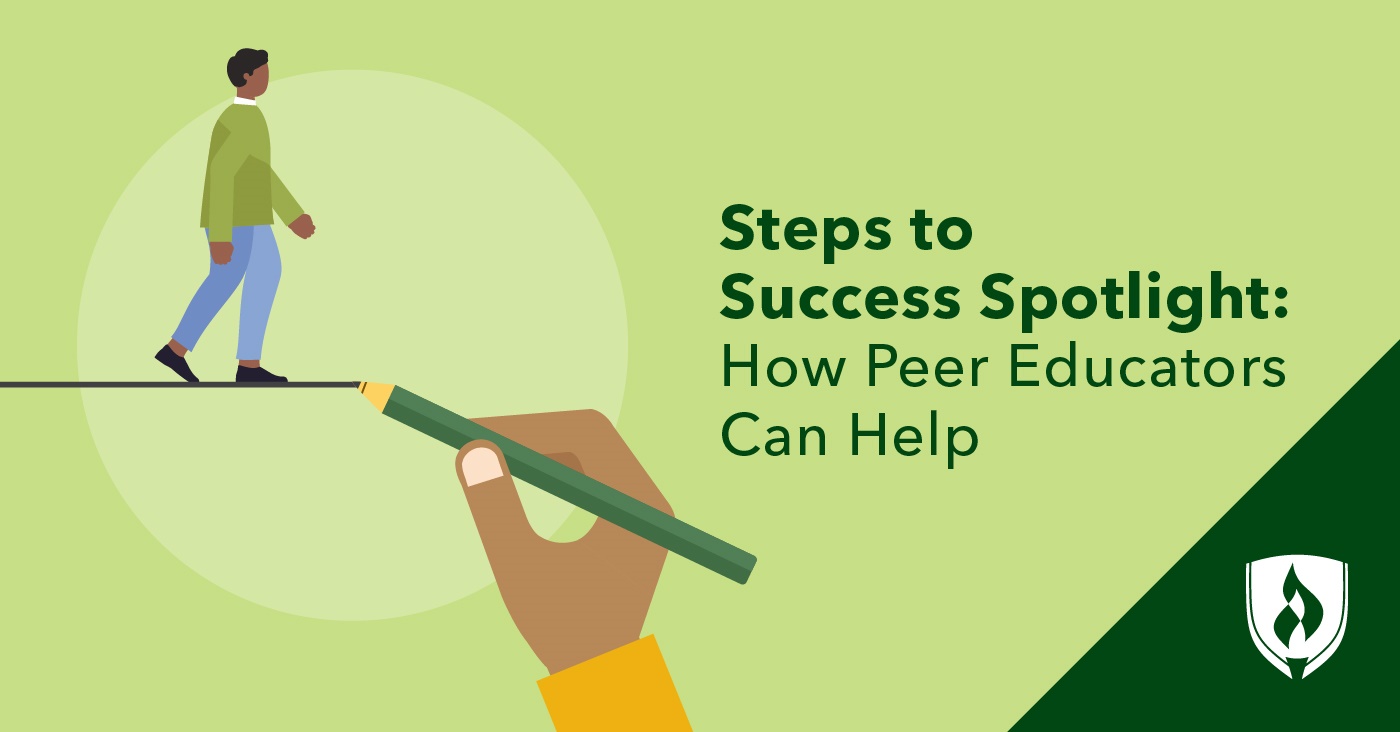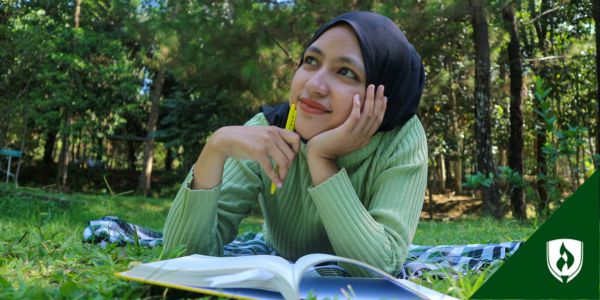
Going back to school at any age is always full of change. That’s especially true if you’re new to online learning. That’s why Rasmussen University offers a variety of student support services and resources designed to help start your academic journey on a positive note. One resource that’s built to assist new students in navigating their online classes and finding good footing in their study is the peer educator program. If you’ve ever wondered what all goes into this program, read on to learn how peer educators continue to make a difference in student success.
What do peer educators do?
Established in 2013, the peer educator program at Rasmussen University is a service provided by the Library and Learning Services team, with a focus that has always been shaped by the needs of students. Formerly known as “peer leaders” or “peer mentors,” peer educators are students who work to help others become comfortable with online learning basics as well as other resources that students can take advantage of while they learn.
Beginning as a program for just one specific class, the peer educator program evolved into a service for all students at Rasmussen University. Peer educators are a point of connection for students: someone who can help them navigate their online courses, find resources and ask questions as they begin their course of study.
According to Tammy Hopps, the Learning Services Coordinator who oversees the program, the intention is to seek feedback from faculty, admissions and other departments to get ideas about what new and current students need to be successful.
“We continually gather information so we can meet the needs of our students,” Hopps explains. “Peer educators are like the palm of a hand, in that they help students with what they need, and where to find it.”
This flexibility and sensitivity to student needs has paid off, as the program recently received a 5-year certification from the College Reading and Learning Association, making Rasmussen University among less than 200 institutions that hold both International Peer Educator and Peer Tutor Training Program Certifications.
What does a peer educator session involve?
Peer educator sessions are available to all Rasmussen University students at any point in their time as a student, and even prior to the start of class. Admissions advisors are now able to help students make peer educator appointments as they enroll, to ensure new students get help before the term begins.
A typical peer educator session takes place online in a virtual meeting room, with the peer educator asking the new student questions in order to get to know them better.
“They will often begin by asking, ‘is there anything that we must cover today?’” Hopps says. “When a student is able to voice their immediate concerns, they are able to relax more, because they know that their issue will be taken care of.”
Amanda Seibert, a peer educator studying Early Childhood Education loves being able to set students at ease.
“My absolute favorite part is getting to talk to new students and work through the anxiety they are feeling,” Seibert says. “Often times, they are overwhelmed and don’t know where to start.”
Through the online session, the peer educator can guide the new student through their new course dashboard, gradebook and other features through the share square.
Unlike peer tutors, who offer content-based support, Hopps emphasizes that peer educators work to provide new students with the information they need to learn efficiently.
“Online course navigation is huge,” Hopps says. “Students come in with the expectation of what they’re going to be doing traditionally—assignments, reading—but in a whole new way, online.”
An empowering connection
Angela Frisbie, a peer educator who is currently working on a Health Information Management degree, remembers having to figure all of these details out on her own at other schools prior to enrolling at Rasmussen University. She sees peer educators as empowering new students with confidence.
“At previous schools, I figured all this out on my own,” Frisbie recalls. “I felt like I was going to fail at it. When I realized how students are given the confidence, not just the information to succeed in their courses, I wish I had the same when I first started learning online.”
Michaela Foss, a mother of three who works full time and is studying Early Childhood Education, is continually finding connections with other students who are parents, too.
"Being a complete stranger’s cheerleader really hypes them up and makes them realize their true potential as a student."
“I meet with a lot of moms who have young kids, or have kids who are older,” Foss says. “Being able to share my experience and tips with them is so rewarding. Being a complete stranger’s cheerleader really hypes them up and makes them realize their true potential as a student.”
How are peer educators selected and trained?
The peer educator role at Rasmussen University is a work/study position and requires a 3.0 GPA to apply.
“If a student has just started, we want them to hold off until they get their sea legs,” Hopps explains.
Hopps says that there is a sweet spot for peer educator candidates: They must have a sufficient amount of experience as a Rasmussen University student, but also have an ample window of time until their graduation so they can be trained and offer services to others. As the training for the role offers the opportunity to earn the CRLA Level 1 credential, potential applicants must also have enough availability to put in the hours to do so.
Training for peer educators is a three-week process involving webinars, reflection papers and mock sessions where established peer educators walk future peer educators through the process.
Foss found the peer educator training very interactive.
“The trainers ensured understanding of the material and allowed me to be hands-on,” Foss recalls. “It was seamless and very well organized.”
What kinds of students are successful peer educators?
When Tammy Hopps interviews prospective peer educators, she is looking for people with empathy.
“We know through research that if somebody feels cared about and supported, they are going to take more risks, do all those things they need to do as a new student,” Hopps says. “Even when students have the skills necessary for academic success, there’s a psychological piece that has to be present as well. Having someone in their corner gives students confidence.”
Hopps also believes successful peer educators are able to manage change well, as the program itself is always evolving to meet student needs. Hopps considers the peer educator program as best defined by the peer educators themselves.
She loves a quote from Antoine de Saint-Exupery, author of the classic book The Little Prince:
“If you want to build a ship, don’t drum up the men to gather wood, divide the work and give orders. Instead, teach them to yearn for the vast and endless sea.”
“We talk about legacy a lot in peer education,” Hopps says. “It’s not about following a path. It’s about having a vision and the power and skills to blaze your own trail. This is not my program—this is the peer educators’ program. I’m just here to guide and help and give them materials to build the ship.”
What are the benefits of being a peer educator?
Seibert is pleased to add the internationally recognized CRLA credential to her resume. She also reports that the training helped her gain valuable transferable skills.
“You can gain a lot of important soft skills that will help in your professional field, such as self-management, organization, time management, office tech skills, excellent communication skills and more,” Seibert says.
Insight into her own career interest is also another benefit of Seibert’s work in the program.
“I entered Rasmussen with the idea of teaching young children but have since gained a new passion for academic support in general,” Seibert says. “Moving forward, I would love to help learners of all ages.”
Frisbie believes that her work as a peer tutor has given her a wide perspective on teaching and learning.
“You meet so many different people from all different places, walks of life,” Frisbie says. Working with many nursing students has given Frisbie a new view on that profession.
“I know what nurses go through, in school,” Frisbie explains. “It’s incredible that they keep going. I have such great respect for nurses.”
"By helping other students, I've also helped myself."
Foss reports that being a peer educator has changed her for the better, by helping her realize her potential and learning life-changing tips on time management and studying. Most significantly, it’s affirmed her choice of profession.
“It has shown me that I am in fact meant to be an educator,” Foss says. “By helping other students, I’ve also helped myself.”
Find the support you need at Rasmussen University
Have questions? Wondering about how to access resources for your courses? Need a little support to keep you going? Making an appointment with a peer educator might be just what you need to boost your confidence and get you back on track. To learn about other resources you can access as a student, check out our article, “11 Surprising Student Resources You Didn’t Know Rasmussen University Offered.”




